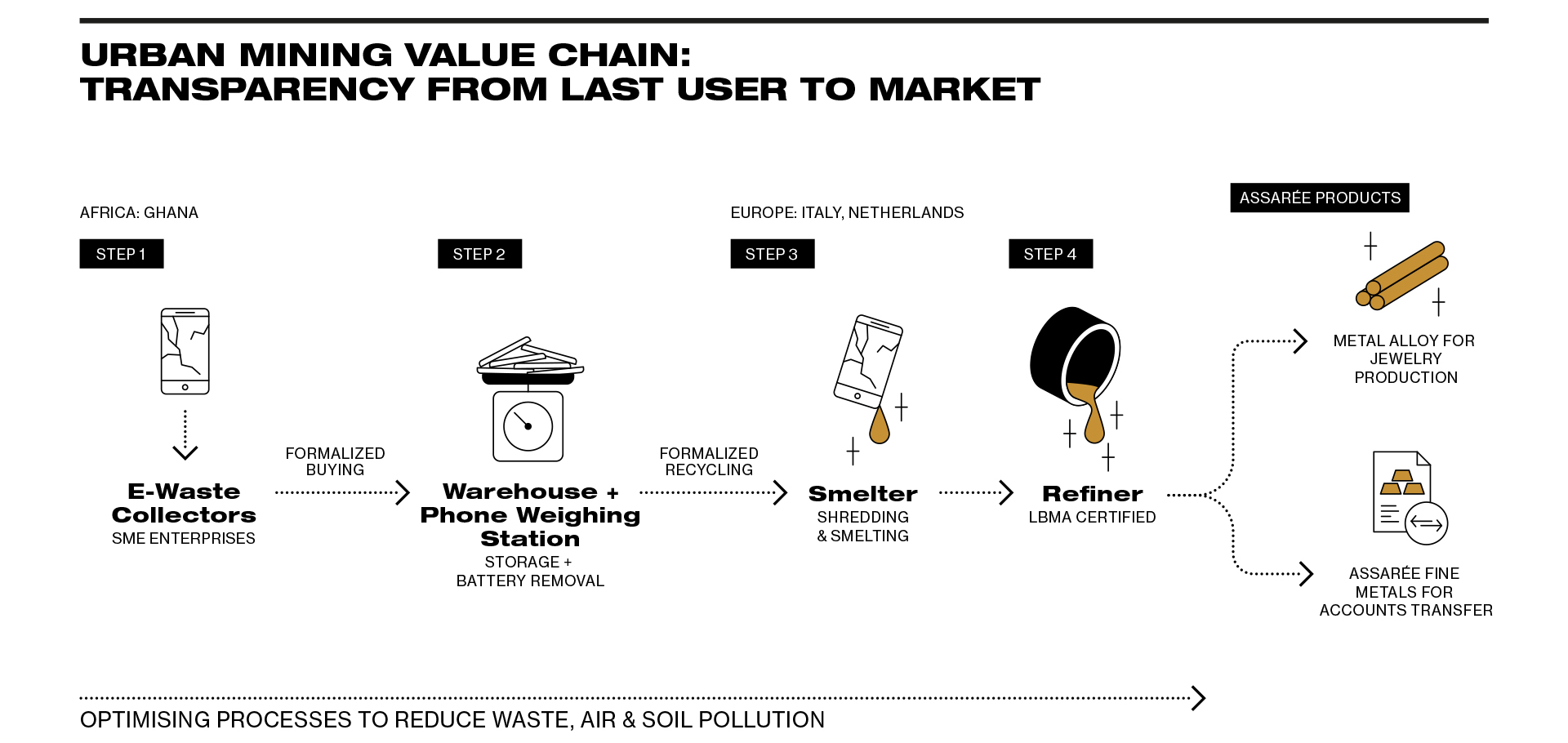URBAN MINING VALUE CHAIN

Transparency from Last Smartphone User to Market
Systemic issues
- The electronics sector creates 20-50 million tons of discarded E-waste each year and growing (7% of annual gold consumption goes into electronics production)
- Post-consumer electronics are shipped to developing nations for the second-hand market and then often end up in landfills
Environmental, Social & Governance issues (ESG)
- Unregulated urban mining practices such as the burning of electronics creates air and soil pollution and negatively affect the health of the miners and neighboring communities
- Today’s main collection streams are informal and untransparent, often even including minors
Unique: Assarée has a unique impact approach together with its impact partners, focusing on transparency rather than standards and a step-by-step impact road map rather than certification.
The urban mining value chains Assarée engages with are unique in only using four value chain steps from landfill to market; E-waste collection (SMEs) (Phones & Tablets), weighing of the E-waste in a warehouse, shredding and smelting, and lastly refining, which is all transparently displayed. An industry game-changer in the Assarée urban mining value chains is that the warehouse only buys the whole electronics from the E-waste collectors rather than just the precious metals, setting the right incentives for landfill clearance as well as the recollection of precious metals, reducing air and soil pollution.
Transparent: being transparent provides knowledge through access and visibility to current supply chain practices. It further allows impact programs to be co-created and measured along the entire value chain. #KnowYourSource (KYS)
All partners along the value chain have committed to integrating transparency as the baseline of their activities, following Assarée’s claim that “without transparency, there is no sustainability.”
Impactful: social and environmental impacts are inherently interlinked and, in combination, lead to sustainable, long-lasting impact programs for resilient, thriving communities and an attraction towards clean production processes.
MATERIAL IMPACT ICONS
In partnership with Transparence S.A., Assarée has created an impact iconography to transparently outline the social and environmental impact factors, together striving towards climate positive operations and thriving local communities.
Sustainable impact creation is a journey shared with clients through foremost transparent impact reporting and impact trips along the value chains.
Environmental impact factors & corresponding SDG’s


Waste reduction
Clearing landfills from electronics toxic waste (SDG 12)
Reduce soil pollution
Precious metals get recollected from e-waste in a closed recycling process, avoiding soil pollution (through heavy metals such as Kobalt, Cadmium and Lithium) (SDG 15)
Reduce air pollution
Precious metals get recollected from e-waste in a closed recycling process, avoiding air pollution (SDG 11/15)
Social & Governance impact factors & corresponding SDG’s


Formalized Recycling
Recycling happens in a formalized process, preventing health and safety issues as well as soil and water pollution. (SDG 8/9/15)
Small and Medium-sized Enterprises (SMEs)
Enabling the development of, or working with SMEs created by local communities (SDG 8)
Community Empowerment
Every impact step should lead to a sustainable business model that can be run independently of the impact designer (SDG 8/11/12)
*ESG:
Environmental, Social, and Corporate Governance refers to the three central factors in measuring the sustainability and societal impact of an investment in a company or business.
**SDG:
The UN Sustainable Development Goals are a collection of 17 interlinked global goals designed to be a “blueprint for achieving a better and more sustainable future for all.”
